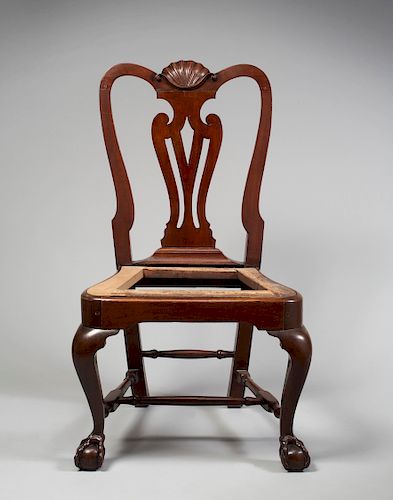FINE AND RARE QUEEN ANNE SHELL-CARVED MAHOGANY SIDE CHAIR, Newport, Rhode Island, circa 1765
Lot 8
About Seller
Keno Auctions
127 East 69th Street
New York, NY 10021
United States
Keno Auctions is renowned for our expertise in fine and decorative arts. With more than 30 years experience, founder Leigh Keno has established a brilliant team of experts specializing in fine art, furniture, decorative arts and jewelry.
Categories
Estimate:
$3,000 - $6,000
Absentee vs Live bid
Two ways to bid:
- Leave a max absentee bid and the platform will bid on your behalf up to your maximum bid during the live auction.
- Bid live during the auction and your bids will be submitted real-time to the auctioneer.
Bid Increments
| Price | Bid Increment |
|---|---|
| $0 | $25 |
| $100 | $100 |
| $2,000 | $250 |
| $5,000 | $500 |
| $30,000 | $2,500 |
| $50,000 | $5,000 |
| $100,000 | $10,000 |
| $500,000 | $10,000 |
| $1,000,000 | $10,000 |
About Auction
By Keno Auctions
Jan 24, 2020
Set Reminder
2020-01-24 15:00:00
2020-01-24 15:00:00
America/New_York
Bidsquare
Bidsquare : Important Americana – Featuring Furniture and Folk Art from a Distinguished NY Collection
https://www.bidsquare.com/auctions/keno/important-americana-featuring-furniture-and-folk-art-from-a-distinguished-ny-collection-4838
Keno Auctions Leigh@kenoauctions.com
Keno Auctions Leigh@kenoauctions.com
- Lot Description
This chair is a rare example of a Newport side chair attributed to the shop of John Goddard. Made when the "Queen Anne" style stiles and splats of Boston chairs, with their s-shaped profile, had run their course as "stylish", the profile of the back has a gentle c-shape. Tables, case-pieces and chairs from Goddard's shop exhibit a distinctive claw and ball foot which stands out as the most naturalistic of all Newport feet. As seen on the present chair, the carver captured the tension in the grip of the talon's around the ball. Compared to the classic "arrow-shaped" stretcher terminals found on (earlier) Boston chairs dating c. 1730-1750, the slender stretchers terminating in round shouldered swells on the present chair are typical of Rhode Island Craftsmanship and particularly that of Goddard's Newport shop. Also, as seen on the present example, the outer surface of the front seat-rails of Newport Chippendale chairs exhibit an almost straight profile. In order to achieve this, the chair-maker fashioned the upper leg-stock so that it curved horizontally towards the center of the chair so that the mortised front seat-rail only has a slight convex outer surface. This is a distinct innovation from the "balloon-seat" (compass seat; "cheek bottom") shape of earlier "Queen Anne" Boston chairs c. 1735-1750. It is a distinctive change in construction which appears to be distinctive to Newport Chippendale chairs. The motives for this innovation are lost to history but it would appear that reducing the carving needed to create the seat-rail would result in less time spent making the chair. As in any trade, "time is money"; this design innovation would have made the assembly and carving process much easier. Considering the massive amounts of furniture which Goddard and other Newport craftsmen were making for venture cargo (see below), it also makes sense that they were aware of creating a distinctive seat shape, which would help to brand venture cargo pieces as "Made in Newport". Most Newport chairs such as this were made after 1750, when wealthy Newport merchants such as John Banister (Banister's Wharf) began to build both ships to travel to England, as well as (smaller) sloops to travel up and down the coast with furniture for venture cargo. As well as bringing back the latest in London furniture, Newport-built ships traveling to England supplied Newport craftsmen with the most essential element of a chairmakers business- fabrics. This included under upholstery (muslin, webbing, etc.) as well as silk, moreen, harrateen and other cover fabrics. The mid-18th century was the turning point for Boston's decades' long dominance over the market for seating furniture as Newport and New York began to create both expensive and inexpensive furniture for local consumption and as venture cargo. The present chair is a premier example of the type of high quality mahogany seating furniture which was produced during the period when Boston's leadership position in venture cargo furniture was rapidly declining while Newport's trade was growing.Dimensions: H. 81 1/2 in., W. 39 1/4 in., D. 20 1/2 in. Provenance: Sotheby's New York, Important Americana, January 19, 2001, lot 698 Sold for $15,600 (incl. BP) C.L. Prickett Antiques A Distinguished New York Collection of American Furniture and Folk Art. Literature: Identical chairs probably from the same set, with features such as the distinctive pierced splat, are at the Chipstone Foundation (see Oswaldo Rodriguez Roque, American furniture at Chipstone (University of Wisconsin Press, 1984), pp. 122-123, no. 52) and in the Karolik Collection at the Museum of Fine Arts, Boston (see Edward Hipkiss, American Arts at the Boston Museum of Fine Arts, no. 80). For another chair which may possibly be from the same set, see The Magazine Antiques, May, 1971, p. 661. Below is a brief excerpt from an article which discusses the reasons for Boston's dominance over the American colonies venture cargo trade in chairs and other expensive furniture from the 17th to the mid 18th centuries. The article also examines the reasons for the subsequent loss of that dominance in the second half of the century to shipbuilding and trading cities such as Newport and New York. Please see: Joan Barzilay Freund and Leigh Keno, "The Making and Marketing of Boston Seating Furniture in the Late Baroque Style", in American Furniture, 1998, ed. Luke Beckerdite (Hanover, N.H.: University Press of New England, for the Chipstone Foundation, 1998 "Rhode Island ship captains and merchants were among the principal importers of Boston seating furniture. One of the most ambitious Newport merchants of the 1730s and 1740s was John Banister (fig. 54). In a 1739 letter to John Thomlinson of London, Banister noted that Newporters desired "to make themselves Independent of the Bay Government to whom they have a mortal aversion." Banister's frustration stemmed from his own dependence upon Boston suppliers such as upholsterers William Downe and Samuel Grant, from whom he purchased "12 Lea: Chairs" for £19.4 and "18 Lea Chairs" for 32s. respectively, in 1739. Banister's account books reveal that he purchased 144 chairs in Boston between 1741 and 1743. [37] The chairs Banister purchased represent a variety of Boston export styles. On March 31, 1743, he "bought by Mr. Hugh Vans in Boston & Shipped on board the Sloop Ann, Joseph Dean Master for Newport" two dozen chairs, including "6 Leather chairs @ 34 . . . 10.4", "6 Lea back Red @ 34 . . . 10.4", "6 ditto Black @ 38 . . . 11.8", and "6 ditto Horsefoot @ 38 . . . 11.8." Two weeks earlier he had received a cargo via "Capt. Eady" of "30 Chairs Leather Backs & Bottoms @ 38/" totaling £57 and "6 ditto Leather Bottoms @ 35/6" totaling £10.13. "Eady" was likely the aforementioned Jeremiah Eddy, whose name appears frequently in Banister's accounts of that year. Banister also purchased work from [prolific Boston carver] John Welch. An invoice of July 1, 1743, indicates that Banister received "a Lyon Head . . . from Welch" valued at £35.2, which was presumably a ship's figurehead.[38] By the mid-1740s, Rhode Island was entering into an era of improved productivity and prosperity. Local industries were growing, and the colony's merchants and entrepreneurs were beginning to establish regular and direct trade routes with London, Bristol, and other European ports. Before midcentury, Newport did not have the artisan base to support a chairmaking industry, but after 1755, local tradesmen like the Townsends and Goddards began making and exporting seating furniture. Jeanne Sloane estimated that fifty-six cabinetmakers were active in Newport between 1745 and 1774, compared with sixty-four in Boston'a city with a much larger population. Additional measure of Newport's improved industry can be taken from southern port-of-entry records. Between April 6, 1756, and December 24, 1775, at least 128 ships arrived in Annapolis from Boston and at least 67 arrived from Newport. Despite Boston's numerical dominance, the Newport cargoes had a higher percentage of case furniture, tables, and chairs. Newport vessels carried an average of nine pieces per vessel, whereas Boston ships carried an average of three. During this period, 25 case pieces, 20 tables, and 380 chairs arrived in Annapolis from Newport. [39]" FOOTNOTES: [37] John Banister to John Thomlinson, June 1, 1738, Banister Copy Book, 1730-1742, Newport Historical Society. Undated invoices between dated letters, Banister Copy Book. [38] Banister Papers, Newport Historical Society. "Invoice of sundrys recd of Capt. Powers as Letter of Advice of July 1, 1743", in John Banister Invoice Book, 1739, p. 134. [39] Port of Annapolis Entries, Maryland, vol. 1, ms. 21, Maryland Historical Society. Vibert, "Market Economy of Newport", p. 23 Above quote and footnotes regarding Boston and Newport furniture trade is taken from: Joan Barzilay Freund and Leigh Keno, "The Making and Marketing of Boston Seating Furniture in the Late Baroque Style", in American Furniture, 1998, ed. Luke Beckerdite (Hanover, N.H.: University Press of New England, for the Chipstone Foundation, 1998)Surface has been lightly cleaned but retains warm color, one knee return replaced
Condition
- Shipping Info
-
Buyer Pays Shipping Cost
-
- Buyer's Premium



 EUR
EUR CAD
CAD AUD
AUD GBP
GBP MXN
MXN HKD
HKD CNY
CNY MYR
MYR SEK
SEK SGD
SGD CHF
CHF THB
THB





















